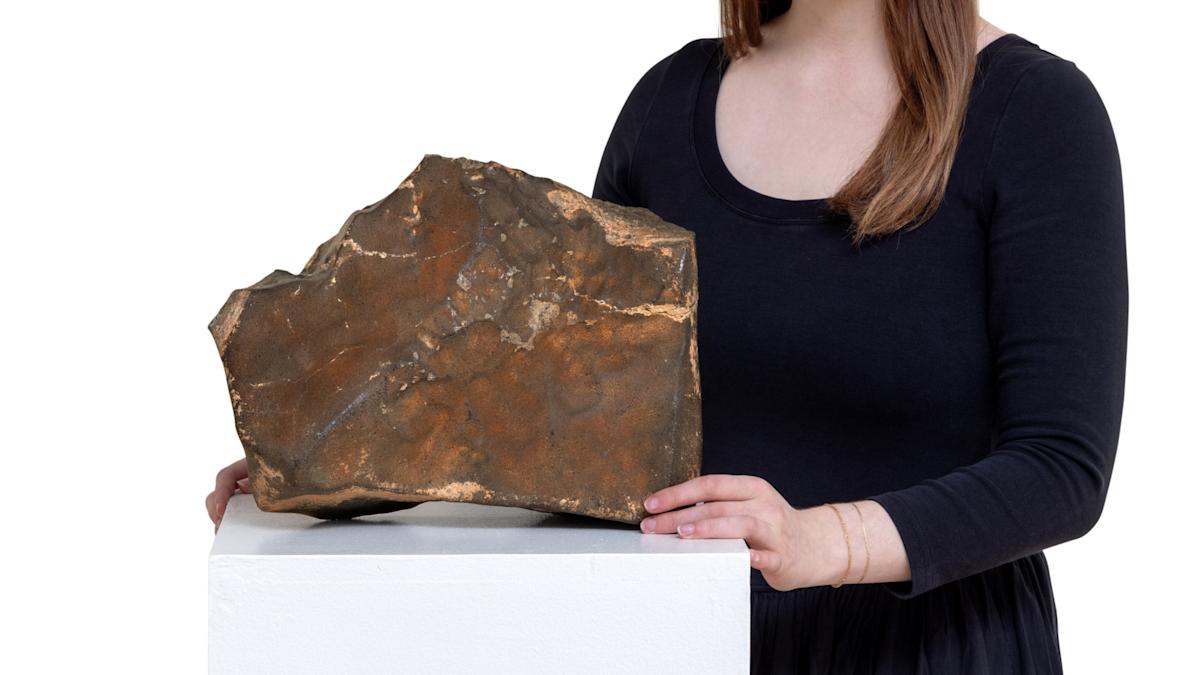
Someone paid $5.3 million for a piece of Mars
How did your country report this? Share your view in the comments.
Diverging Reports Breakdown
Someone paid $5.3 million for a piece of Mars
The Red Planet meteorite was discovered in 2023 in a remote area of the Sahara Desert in Niger. It’s about 70 percent larger than the second-biggest piece of Mars found on Earth. The winning bid was for $4.3 million, making it the most valuable meteorite ever sold. Only 400 of the 77,000+ officially recognized meteorites hail from Mars.
Martian meteorites of any size are incredibly rare. To get here, an asteroid first hits the Red Planet to eject material from its surface. (Sotheby’s says there are only 19 Martian craters large enough to have spit out this one.) That chunk then has to travel 140 million miles through space to reach Earth. Only 400 of the 77,000+ officially recognized meteorites hail from Mars.
The meteorite is known as NWA 16788. Its reddish-brown, scarred exterior almost looks like the Red Planet’s surface in miniature.
Sotheby’s
This is also an exceptionally big Martian meteorite. It’s about 70 percent larger than the second-biggest piece of Mars found on Earth. It measures 14.75 x 11 x 6 inches and weighs over 54 lbs. It’s big enough to represent about 6.5 percent of all known Martian material on our planet.
ADVERTISEMENT Advertisement
The winning bid was for $4.3 million. After fees, that comes out to over $5.3 million, making it the most valuable meteorite ever sold.
Before bidding, the auction house sent a small piece of the space rock to a lab, which confirmed its distinctly Martian chemical composition. Over 21 percent of the rock is composed of maskelynite, a glass produced when the asteroid struck the Martian surface.
Record-Breaking $5.3 Million Paid for Rare Mars Meteorite at Sotheby’s Auction – channelnews
The meteorite, catalogued as NWA 16788, was discovered in 2023 in a remote area of the Sahara Desert in Niger. Only 400 of the more than 77,000 officially recognised meteorites originated from Mars. The meteorite is exceptionally large for a Martian specimen, measuring 14.75 x 11 x 6 inches and weighing over 54 pounds. It represents about 6.5% of all known Martian material on the planet. The sale reflects growing interest in space collectibles as private space exploration companies and renewed government focus on Mars missions have increased public fascination with the Red Planet. The record price reflects not only the meteorite’s scientific significance but also its status as one of the most exclusive collectibles available.
The winning bid of $4.3 million, which reached $5.3 million after fees, represents the premium collectors are willing to pay for authentic pieces of the Red Planet.
The meteorite, catalogued as NWA 16788, was discovered in 2023 in a remote area of the Sahara Desert in Niger.
Its reddish-brown, scarred exterior resembles the Martian surface in miniature, providing a tangible connection to the distant planet that has captivated human imagination for centuries.
Martian meteorites represent some of the rarest space materials available to collectors and scientists.
For this rock to reach Earth, an asteroid first had to strike Mars with sufficient force to eject material from its surface, with Sotheby’s noting that only 19 Martian craters are large enough to have produced such specimens.
The ejected material then traveled approximately 140 million miles through space before landing on Earth.
The exceptional rarity of Martian meteorites is underscored by statistics showing that only 400 of the more than 77,000 officially recognised meteorites originated from Mars.
This scarcity, combined with the scientific and cultural fascination with Mars exploration, drives the premium pricing for authenticated Martian materials.
The record-setting meteorite is exceptionally large for a Martian specimen, measuring 14.75 x 11 x 6 inches and weighing over 54 pounds.
Its size makes it approximately 70% larger than the second-biggest piece of Mars found on Earth, representing about 6.5% of all known Martian material on the planet.
Before the auction, Sotheby’s sent a sample of the space rock to laboratory analysis, which confirmed its distinctly Martian chemical composition.
Over 21% of the rock consists of maskelynite, a glass formed when the original asteroid impact struck the Martian surface, providing scientific evidence of its extraterrestrial origin and violent journey to Earth.
The sale reflects growing interest in space collectibles as private space exploration companies and renewed government focus on Mars missions have increased public fascination with the Red Planet.
The meteorite market has evolved into a specialised collecting category where rarity, size, and provenance determine extraordinary valuations.
The previous record for meteorite sales pales in comparison to this transaction, demonstrating how unique specimens from other planets command premium prices among collectors willing to own tangible pieces of space exploration history.
The buyer’s identity was not disclosed, following typical auction house practices for high-value transactions.
For scientists, Martian meteorites provide invaluable research opportunities to study Mars’ geology, atmosphere, and potential for past life without the enormous costs of sample return missions.
Each specimen offers insights into Martian composition and history that complement data gathered by rovers and orbital missions.
The sale occurs as multiple space agencies and private companies prepare for human missions to Mars, potentially making authentic Martian materials even more valuable as cultural artefacts representing humanity’s relationship with the Red Planet.
The meteorite will likely be preserved as both a scientific specimen and a symbol of our solar system’s dynamic geological processes.
The record price reflects not only the meteorite’s scientific significance but also its status as one of the most exclusive collectibles available, accessible only to individuals with substantial resources and appreciation for extraterrestrial materials that represent billions of years of cosmic history.
Source: https://www.engadget.com/science/space/someone-paid-53-million-for-a-piece-of-mars-191502853.html
